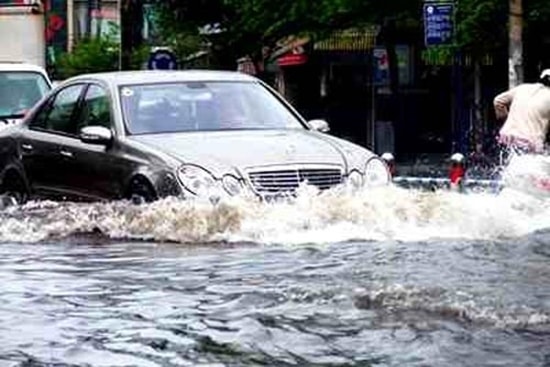4 things to do immediately to minimize damage when your car is unfortunately flooded
When your car is flooded, handling it wrong can cause many times the damage, even completely ruining the engine. Here are four important things you need to do right away to protect your car and reduce the risk of serious damage.

Floods can not only destroy homes and property, but can also cause extensive damage to vehicles. For many people, a car is not just a means of transportation but also a major investment, so seeing it submerged in water is a haunting experience.
Floodwaters can seep into the engine, transmission, electrical system, and interior, causing damage that sometimes takes months to notice. However, if you act quickly after a car is flooded, you can significantly limit the damage, or even save your car from total destruction.
1. Call for help and do not start the car.
Even if the car is only partially submerged, trying to start the engine can make the situation much more serious. When water enters the engine compartment, electrical system or air intake, starting can cause “hydrolock”, in which water is sucked into the cylinder, preventing the piston from compressing and causing the connecting rod to bend or completely destroy the engine. In many cases, just pressing the start button is enough to force the car to have a replacement engine, with repair costs running into the hundreds of millions of dong.
Instead of trying to start or drive your vehicle out of a flooded area, you should stay put and contact a rescue team or professional towing service to move your vehicle to safety.
2. Remove water and dry the interior as soon as possible
Once the vehicle has been removed from the flooded area, the first thing to do is to remove all the remaining water from the interior. Water and moisture that has accumulated over time not only causes rust on metal parts but also creates conditions for mold, odors and bacteria to grow, factors that can cause permanent damage to the vehicle's interior.
Start by using a wet vacuum to remove any standing water from the floor and crevices. Next, use a dry towel or microfiber cloth to absorb any remaining moisture from the seats, carpets, and dashboard. Once most of the water has been removed, turn on the fan or use a dehumidifier to speed up the drying process inside the car.
If possible, remove all floor mats, seats and cushions and let them dry in the sun or in a well-ventilated area. This will not only help prevent mold but also reduce unpleasant musty odors, helping your car quickly return to a safer and cleaner state.
3. Check engine oil, transmission oil and other fluids
After a vehicle has been flooded, one of the most important steps is to check the condition of the fluids, including engine oil, transmission fluid, brake fluid, coolant, and fuel. If water has entered these systems, it can cause serious damage to the engine and internal mechanical components.
The signs are quite obvious, such as oil or gasoline contaminated with water often turns cloudy like coffee with milk, or has tiny bubbles. When detecting this condition, absolutely do not start the vehicle, because starting the engine can cause water to be sucked deeper into the lubrication system, causing corrosion and damage to metal parts.
Instead, drain the entire contaminated fluid and replace it completely. If you don't have the tools or experience, it's best to contact a professional auto repair shop.
You should ask them to come and inspect the car on site, or if you need to move the car, use a professional towing or transport service to avoid making the car worse. Proper handling at this stage can make the difference between saving your car or having to replace the entire engine.
4. Check the vehicle's electrical system carefully
Water can seriously damage almost every part of your car, especially the electrical systems and electronic components, which are sensitive to moisture. After a car has been flooded, carefully check the entire inside of the cabin, including the lighting system, sound system, air conditioning, electric windows, central locking, electric mirrors and dashboard indicators.
If you notice flickering lights, a buzzing sound, slow windows, unusually illuminated warning lights, or any other unusual signs, do not attempt to use the vehicle. These minor problems could be a sign of moisture or a short circuit within the electronic system, and if ignored, could lead to a fire or complete failure of the electronic control unit (ECU).
In any case, take your car to a professional garage or auto electrician for a thorough inspection. Technicians have specialized equipment to measure humidity, check electrical circuits, and promptly handle points at risk of short circuits. Early inspection not only helps ensure the safety of the car but also prevents hidden damage that may arise later./.


